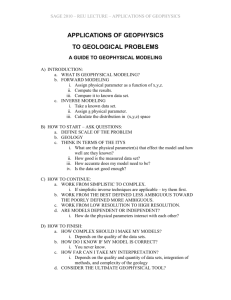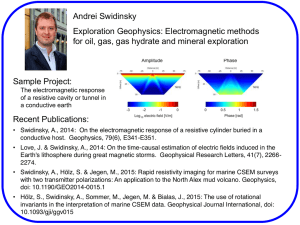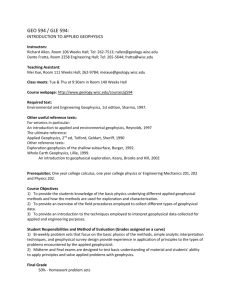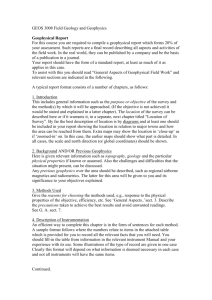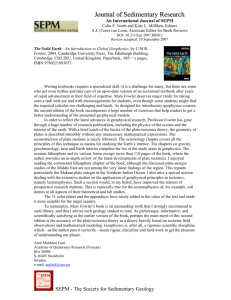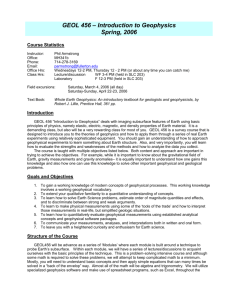Introduction to Applied Geophysics
advertisement
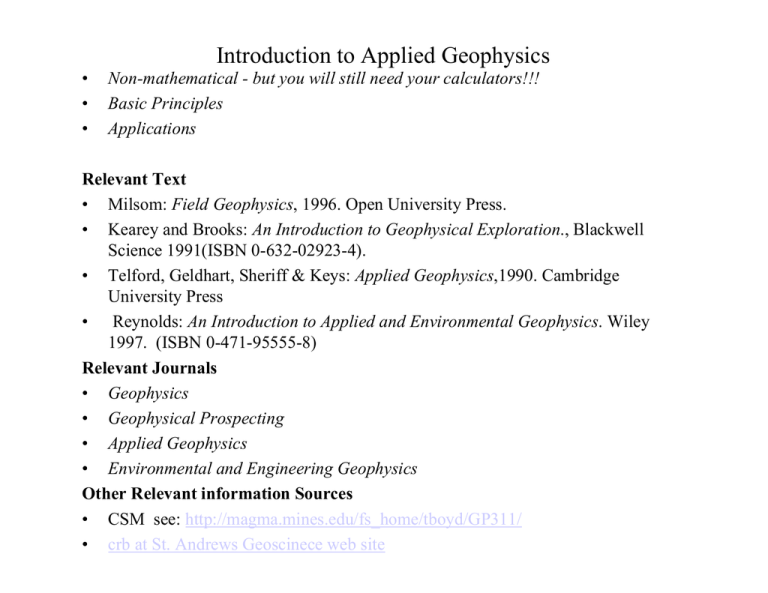
Introduction to Applied Geophysics • • • Non-mathematical - but you will still need your calculators!!! Basic Principles Applications Relevant Text • Milsom: Field Geophysics, 1996. Open University Press. • Kearey and Brooks: An Introduction to Geophysical Exploration., Blackwell Science 1991(ISBN 0-632-02923-4). • Telford, Geldhart, Sheriff & Keys: Applied Geophysics,1990. Cambridge University Press • Reynolds: An Introduction to Applied and Environmental Geophysics. Wiley 1997. (ISBN 0-471-95555-8) Relevant Journals • Geophysics • Geophysical Prospecting • Applied Geophysics • Environmental and Engineering Geophysics Other Relevant information Sources • CSM see: http://magma.mines.edu/fs_home/tboyd/GP311/ • crb at St. Andrews Geoscinece web site Applications • • • • Engineering Environmental Groundwater, Mining Geophysical Targets - Environmental Problems for environmental engineers •where did all those nasty contaminants go to? •what will happen if there is a leak here? •how can I design a contamination safety plan Targets for environmental engineers •Confining layers •Barriers to water/contamination •Fractured Bedrock •Coarse channel fill •Weathered bedrock •Perched/permanent water tables •High porosity/permeability confined units IN SUMMARY •Rock Type •Rock Fabric •Geometry •Fluid Content Geophysical Targets - Mining Problems mining engineers •where is the primary resource •How large is the primary resource •How difficult is it to extract the primary resource •How can the primary resource be extracted in an environmentally sensitive manner Targets for mining engineers •Depth to target,size of target •Physical nature of target •Overlying material type and structure •Perched/permanent water tables IN SUMMARY •Rock Type/mineral type •Rock Fabric •Geometry •Fluid Content Geophysical Targets - Engineering Problems for Engineers • How strong is the rock/soil • How easily can it be removed/dug into Targets for engineers •Depth to bedrock •Fractured Bedrock •Coarse channel fill •Weathered bedrock •Perched water tables •High porosity/permeability confined units IN SUMMARY •Rock Type •Rock Fabric •Geometry •Fluid Content Geophysical Targets - Groundwater Ideal Well • High Flow rate • Good Quality • Sustainable Yield • Shallow (ish) Depth Targets for hydrogeologists and geologists •Fractured Bedrock •Coarse channel fill •Weathered bedrock •Perched water tables •High porosity/permeability confined units Typical Well • Variable Flow rate • Variable Quality • Seasonal (intermittent) Yield • Medium to Deep Targets parameters for geophysics •Porosity - primary and secondary •Density •Pore fluid - amount and type IN SUMMARY •Rock Type •Rock Fabric •Geometry •Fluid Content Typical Well Locations - Geophysical Targets Common Well Conditions 1. Shallow perched aquifer in alluvium or weathered bedrock, discontinuous flow rate 2. Deep aquifer, seasonal recharge 3. Bedrock aquifer, sustainable yield, low flow rate 4. Bedrock aquifer, sustainable yield, high flow rate Perched WT 3/4 1 2 3 1 4 WT Fracture zone Weathered horizons Clay Alluvium Sand and Gravel Granite Global Scale Regional Local/ Field Scale Hand specimen Scale Field Scale Microscopic clay rich channeling weathering secondary fracturing sand rich fracturing Micro Scale Factors influencing Porosity - fabric Packing 100Vv n= Vt Porosity = 47.65% ρb n = 1001 − ρd Where Vv - void volume Vt - total volume b - bulk density d - particle density Porosity = 25.95% Density (rock type) is important Factors influencing Porosity - fabric Shape mixed grain sizes reduce porosity Fabric (rock type) is important Factors influencing Density Mineral Type Different minerals have different densities Density of minerals (rock type) is important Factors influencing Strength and Geophysical Signatures In homogeneous, isotropic media the velocities of compression and shear waves can be described in simple terms of elastic modulii and density. (4 µ + k) 3 Vp = ρ Bulk Modulus (k)- incompressibility of the medium µ Vs = ρ ∆P k= ∆v / V Shear Modulus( µ ) - resistance to shearing; shear stress/shear strain. Note that from the above equations, it is implied that fluids and gases do not allow the propagation of S waves. τ µ= Any changes in the shear or bulk modulii or the density will therefore cause a change in shear and compression velocity ε Factors influencing Porosity - cements & fracturing Secondary Porosity NB these diagenetic changes also affect the material strength Fracturing Cementation e.g. calcite, dolomite, silica Diagenesis (rock type) is important Hydrogeological factors of geophysical interest Specific yield - ratio of the volume of water that drains from a saturated rock owing to attraction of gravity, to the total rock volume (Sy) Specific retention - ration of water retention to total rock volume (Sr) specific retention specific yield Porosity, n = Sy + Sr, also remember ρb 100Vv n= , n = 100 1 − Vt ρd Hydraulic Conductivity and Specific Yield Specific Yield in % (after Fetter) Material Clay Sandy Clay Silt Fine sand Medium sand Coarse sand Fine gravel Medium gravel Coarse gravel Maximum 5 12 19 28 32 35 35 26 26 Minimum 0 3 3 10 15 20 21 13 12 Average 2 7 18 21 26 27 25 23 22 Other Geophysical Properties • Thermal conductivity • Radioactivity Newton’s Second Law of Gravitation (motion) However, when measuring the Earth’s gravity we measure the acceleration (g) resulting from the gravitational attraction. Newton’s Second Law Force is proportional to acceleration F = m2 g Thus from 1) and 2) Gm1 g= 2 r G=6.67x10-11Nm2kg-2 Magnetic Fundamental Principles Couloumb’s Equation The expression for magnetic force experienced between two magnetic monpoles is given by 1 ρ1 ρ2 Fm = 2 µ r where µ is the magnetic permeability, p1and p2 are the strengths of two magnetic monopoles Note similarity with Newton’s Universal Gravity Law Gm1m2 Fg = 2 r Electrical Resistivity - Conductivity Ohm’s Law Empirical relationship between the current (I) flowing through a wire, of resistance R and the voltage potential (V) required to propagate the current. V = IR Further L R ∝ A where L is the length and A the cross sectional area of wire. However, as we are not concerned with wires in the Earth, and electrical current is not constrained, the resistivity, ρ of a material is a more useful concept where. ρ = RA L or ρ = VA IL Summary of Geophysical Target Properties • • • • • • Density Magnetic Susceptibility Velocity (p and s wave) Attenuation Resistivity Relative Dielectric Constant • Rock Type • Pore (fluid) Content • Geometry Geophysics The Study of the Earth Using Quantitative Physical Methods Remote Insight into the Earth Objectives of Geophysical Investigation • Remotely map changes in subsurface geologic and hydrogeologic conditions • Optimise locations for drilling wells • Recognize and map economic resources • Extend “Ground Truth” knowledge from boreholes into formations Geophysical applications • Whole Earth Geophysics - Classical Geophysics • Exploration Geophysics - measure specific physical properties of the earth to determine subsurface conditions and typically locate an economic resource (typically oil, gas and minerals but also includes water) • Characterization Geophysics - remotely map changes in subsurface geologic, engineering and hydrogeologic conditions (map distribution and properties of aquifers and aquicludes) Exploration, Groundwater and Environmental Geophysics Exploration Oil and Gas • Structural Highs • Reservoir Seals • High porositypermeability formations • Station spacing >25m • Resolution 5-15m • Seismic Reflection dominant • Targets 1-6km Adapted from Steeples Characterization Groundwater • Structural Lows • Reservoir Seals & leaks • High porositypermeability formations • Station spacing 125m • Resolution 0.5-10m • Multi-technique Environmental • Structural Lows • Reservoir Leaks • Targets 10m-1.5km • Targets 1m-500m • Low porositypermeability formations • Station spacing <3m • Resolution 0.5-2m • Multi-technique Geophysics doesn’t/didn’t Work!! The geophysical methods are/were not used in an appropriate manner/setting Key points • Geophysics is just another tool to help solve geologic/hydrogeologic problems • Geophysics measures physical parameters that must be interpreted in terms that the end user will understand • There is rarely a unique geophysical solution • To ensure success, every geophysical survey must be conducted within an appropriate geologic framework Geophysical Methods Active • Artificially generate a signal • Transmit this through the Earth and record changes to signal e.g. – Seismic reflection and refraction surveying – Direct current electric methods – controlled source electromagnetics Passive • Detect variations in natural fields associated with Earth e.g. – Gravity surveying – Magnetic surveying Geophysical Methods and Physical Properties Method Property Electrical Electrical & Electromagnetic Conductivity (resistivity) Major Influence Typical Ranges Lithology (clay content) Moisture (dissolved solids) Lithology (magnetic mineral) 104 (sea water) to 10-4 (dry sand) millimohs/m Lithology (mineral, porosity) 10-6 (sediments) to 102 (iron alloys) Gravity Density Magnetic Magnetic Susceptability Seismic Seismic Lithology (porosity, velocity/attentuation saturation, pressure) 102 (soil) to 104 (massive rocks) m/sec Ground Penetrating Radar Dielectric constant 10 (ice) to 102 (water) Lithology, watercontent, density 0 (air filled void) to 1 (sediments) to 3 (massive rocks) gm/km Note: Geophysics measures properties that are not unique to a particular soil or rock type! The Geophysical Survey - Budget • Staffing • Operating Costs – general logistics - non-specific equipment, transportation, access, damages, politics, social constraints, – geophysical equipment - cost of rental, depreciation • • • • Insurance - liability Overhead - administrative, consumables Development - skills, software Contingencies - something unplanned for will always happen! Planning a Survey Define Objectives •Resolution •Cultural factors •Cost •QA/QC •Safety •Data reduction Forward Model Field Operations plan •Line/Station/Grid Processing/interp •Integration Desk Top Survey Cost evaluation Recommend No Geophysics Select Geophysics Methodology Site Check BAD Recommend No Geophysics GOOD Survey Design Data Collection, Processing, Interpretation Data Integration, Presentation and Recommendation Data Reduction - Data Processing - Data Presentation How is data to be reduced? • Computer aided? • Hand analysis and drafting? How is data to be processed? • Computer aided? • Don’t collect more data than you can process - this is a great temptation with digital acquisition How is data to be interpreted? • If computer aided interpretations used are the results geologically/hydrogeologically realistic? • Contouring is a particular problem with some sparse data sets Final data presentation? • How will the information finally be presented? Can the data be converted into a useable form for presentation to the client? Noise •Coherent - systematic noise that can be filtered e.g. power line •Incoherent - random noise that can be stacked e.g. wind Noise Sources Cultural (manmade) Natural Dynamic • Electrical power • Radio transmitters • Vehicle Static • Buried pipes • Drains • Foundations • • • • • • Any geologichydrogeologic noise not related to target Rain Wind Wave Electrical Storms Magnetic Storms Noise Sources The Geophysical Survey - Typical Survey Types Sounding - 1D • measure variation in properties (usually with depth) at one physical location on surface, e.g. electrical sounding giving “borehole like” result Profiling - 2D • measure variation in properties along the surface of a 2D cross section • must consider line orientation (usually perpendicular to anticipated major anomaly or strike of target) Mapping - 2 ½D • usually involves extrapolating between a number of parallel profiles • join all points of equal value with isolines (equivalent to contours on a map) Mapping - 3D • grid of survey points simultaneously recording (live) for every source initiation 4D - 3D • 3D data acquired using time lapse Resolution Critical to all types of survey is the issue of required survey resolution. This is a function of sampling and can be either a time criteria or a distance criteria • Station spacing/station interval lead to spatial aliasing • line interval lead to issues of spatial aliasing too small: spatially undersampled too small: waste time and money too large: miss target completely Rule of Thumb Geophysical signature (anomaly) typically at least twice actual size of feature. Spatial Aliasing Aliased (undersampled) • (spatial) loss of high frequency information 2D - True Profile Data Optimally sampled Oversampled 3D example - “Bulls Eye” Effect Data Interpretation and Presentation Qualitative • Pattern recognition – Can be applied to any data (property) set – Correlate a certain geologic (hydrogeologic) condition with a geophysical character or range or values. – Change in values is usually the important criteria – Target will not be identified if the variations in properties of the background material are similar in contrast and scale to those associated with the target. Quantitative • inversion • numerical modeling • neural networks Line Profiling - 2D data 30 20 10 0 30 Fracture Zone 20 10 EM 34 Horizontal Coils, 20m spacing EM 34 Vertical Coils, 20m spacing 0 Linear position Data Presentation - 3D data 90.00 180.00 85.00 80.00 175.00 180.00 75.00 70.00 170.00 175.00 65.00 60.00 165.00 170.00 55.00 50.00 160.00 165.00 45.00 40.00 155.00 160.00 35.00 30.00 150.00 155.00 25.00 20.00 145.00 150.00 15.00 160.00 170.00 180.00 190.00 200.00 210.00 10.00 145.00 160.00 170.00 180.00 190.00 200.00 210.00 90.00 180.00 85.00 180.00 80.00 175.00 75.00 175.00 70.00 170.00 65.00 170.00 60.00 165.00 55.00 165.00 50.00 160.00 45.00 160.00 40.00 155.00 35.00 155.00 30.00 150.00 25.00 150.00 20.00 145.00 15.00 145.00 160.00 160.00 170.00 180.00 190.00 200.00 210.00 180.00 90.00 85.00 175.00 80.00 75.00 170.00 70.00 65.00 165.00 60.00 55.00 160.00 50.00 45.00 40.00 155.00 35.00 30.00 150.00 25.00 20.00 145.00 15.00 160.00 170.00 180.00 190.00 200.00 210.00 10.00 170.00 180.00 190.00 200.00 210.00 Simple Contour Map 180.00 175.00 170.00 165.00 160.00 155.00 150.00 145.00 160.00 170.00 180.00 190.00 200.00 210.00 Monotonic contour 180.00 90.00 85.00 175.00 80.00 75.00 170.00 70.00 65.00 165.00 60.00 55.00 160.00 50.00 45.00 40.00 155.00 35.00 30.00 150.00 25.00 20.00 145.00 15.00 160.00 170.00 180.00 190.00 200.00 210.00 10.00 Colour Contour Map 90.00 180.00 85.00 80.00 175.00 75.00 70.00 170.00 65.00 60.00 165.00 55.00 50.00 160.00 45.00 40.00 155.00 35.00 30.00 150.00 25.00 20.00 145.00 15.00 160.00 170.00 180.00 190.00 200.00 210.00 10.00 Shaded Relief Map 180.00 175.00 170.00 165.00 160.00 155.00 150.00 145.00 160.00 170.00 180.00 190.00 200.00 210.00 3D Relief
